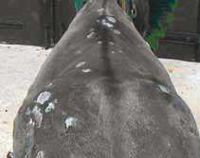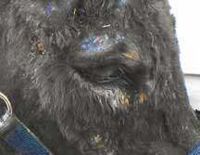Difference between revisions of "Pemphigus foliaceus - Donkey"
m (Text replace - '{{review}}' to '') |
|||
| Line 1: | Line 1: | ||
| − | + | ||
[[Image:Pemphigus donkey.jpg|right|thumb|200px|<small><center>''Pemphigus foliaceous''-like syndrome in a donkey (Image courtesy of [http://drupal.thedonkeysanctuary.org.uk The Donkey Sanctuary])</center></small>]] | [[Image:Pemphigus donkey.jpg|right|thumb|200px|<small><center>''Pemphigus foliaceous''-like syndrome in a donkey (Image courtesy of [http://drupal.thedonkeysanctuary.org.uk The Donkey Sanctuary])</center></small>]] | ||
Revision as of 12:38, 18 March 2010


A condition that is clinically and pathologically indistinguishable from pemphigus foliaceus that affects the mucocutaneous and hoof-skin junctions is encountered from time to time.
Clinical signs
The disease can become generalised and hair loss with circular exudative patches may be encountered. It is usually non-pruritic.
An interesting form of the pemphigus group of conditions involves the coronary bands. Acute, sometimes painful, chronic, fluctuating dermatitis with hypertrophy and prominent scaling and crusting is a feature of this condition. Often the diagnosis is mistaken for laminitis.
Diagnosis
It can be diagnosed from a biopsy of a suitable early lesion.
Treatment
Treatment is largely unrewarding, but high dose steroids can be attempted. Probably the best of these is prednisolone at higher doses at first, tapering the dose progressively down to a minimum effective alternate daily dose. The risks of laminitis following steroid usage in donkeys have not been defined to D. Knottenbelt's knowledge and certainly there does not appear to be a higher risk than in horses (in which D. Knottenbelt believes the risk is heavily overstated).
References
- Knottenbelt, D. (2008) Skin disorders In Svendsen, E.D., Duncan, J. and Hadrill, D. (2008) The Professional Handbook of the Donkey, 4th edition, Whittet Books, Chapter 8
|
|
This section was sponsored and content provided by THE DONKEY SANCTUARY |
|---|